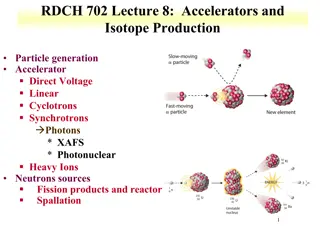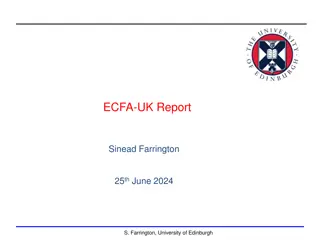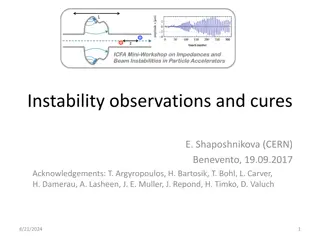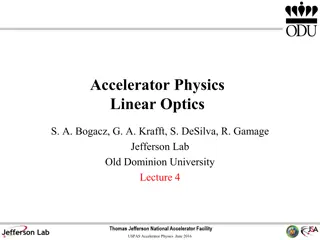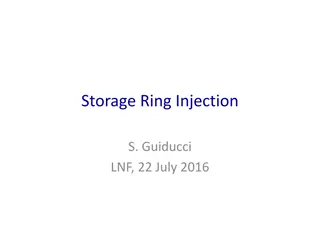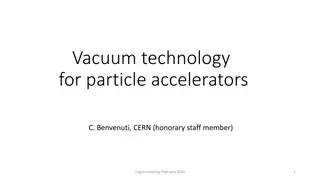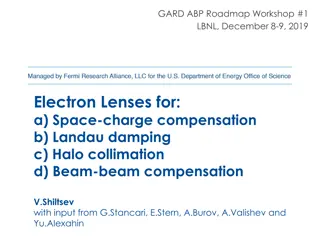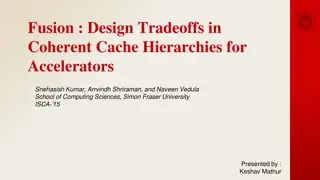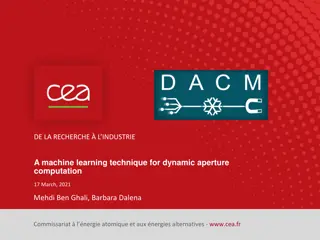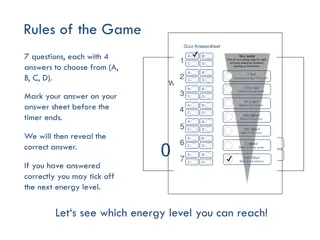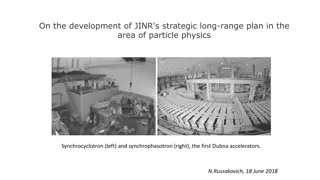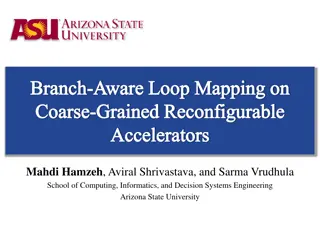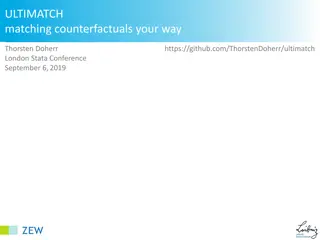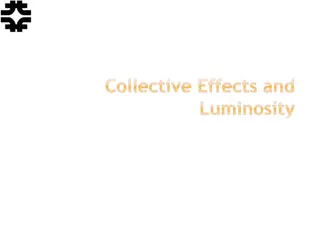Insertions and Matching in Particle Accelerators
Particle accelerators require precise insertions and matching to optimize performance. Learn about lattice functions, Collins insertions, dispersion suppression, and more in this comprehensive guide.
Download Presentation

Please find below an Image/Link to download the presentation.
The content on the website is provided AS IS for your information and personal use only. It may not be sold, licensed, or shared on other websites without obtaining consent from the author.If you encounter any issues during the download, it is possible that the publisher has removed the file from their server.
You are allowed to download the files provided on this website for personal or commercial use, subject to the condition that they are used lawfully. All files are the property of their respective owners.
The content on the website is provided AS IS for your information and personal use only. It may not be sold, licensed, or shared on other websites without obtaining consent from the author.
E N D
Presentation Transcript
Insertions and Matching Eric Prebys, FNAL
Insertions So far, we ve talked about nice, periodic lattice, but that may not be all that useful in the real world. In particular, we generally want Locations for injection of extraction. Straight sections for RF, instrumentation, etc Low beta points for collisions Since we generally think of these as taking the place of things in our lattice, we call them insertions FODO FODO FODO Insertion FODO FODO FODO Match lattice functions Lecture 7 - Lattice Matching and Insertions USPAS, Knoxville, TN, Jan 20-31, 2014 2
Mismatch and Beta Beating Simply modifying a section of the lattice without matching will result in a distortion of the lattice functions around the ring (sometimes called beta beating) Here s an example of increasing the drift space in one FODO cell from 5 to 7.5 m Lecture 7 - Lattice Matching and Insertions USPAS, Knoxville, TN, Jan 20-31, 2014 3
Collins Insertion A Collins Insertion is a way of using two quads to put a straight section into a FODO lattice 1s 1s 2s f f f f f f f f F F L L L 4 4 , , m m m Where s2 is the usable straight region Lecture 7 - Lattice Matching and Insertions USPAS, Knoxville, TN, Jan 20-31, 2014 4
Require that the lattice functions at both ends of the insertion match the regular lattice functions at those point 1 0 1 0 1 1 1 s 1 s 1 s 1 1 1 1 2 1 = M 1 1 0 0 0 F sin F + sin cos sin sin I m I m I = cos m I I m I Where Iis a free parameter After a bit of algebra 2 tan I 2 sin = = = ; ; I s s F 1 2 Maximize s2 with I= /2, max (which is why we locate it L/2 from quad) Works in both planes if x=- y (true for simple FODO) Lecture 7 - Lattice Matching and Insertions USPAS, Knoxville, TN, Jan 20-31, 2014 5
Dispersion Suppression The problem with the Collins insertion is that it does not match dispersion, so just sticking it in the lattice will lead to distortions in the dispersion Collins Insertion This is typically dealt with by suppressing the dispersion entirely in the region of the insertion. Lecture 7 - Lattice Matching and Insertions USPAS, Knoxville, TN, Jan 20-31, 2014 6
Dispersion Suppression (contd) On common technique is called the missing magnet scheme, in which the FODO cells on either side of the straight section are operated with two different bending dipoles and a half-strength quad Straight section Mirror image 1 1 2 2 f f f f f f f 2 Recall that the dispersion matrix for a FODO half cell is (lecture 6) D D 0 0 = M D D 1 1 + 1 + 1 2 L L L 2 1 2 2 L L L L 2 2 2 2 4 f f f 1 1 L L 1 1 0 1 1 0 1 1 0 2 2 2 1 1 f 1 L L L L L = = + M 1 0 0 1 1 0 0 1 1 0 1 2 1 2 3 2 2 2 2 2 4 2 4 8 f f f f f f f 0 0 1 0 0 1 0 0 1 0 0 1 0 0 1 0 0 1 Lecture 7 - Lattice Matching and Insertions USPAS, Knoxville, TN, Jan 20-31, 2014 7
So we solve for 0 D m ( ) ( M ) m = = = M 0 D 2 1 1 1 Where Dm and D m are the dispersion functions at the end of a normal cell (for a simple lattice, D m=0) We get the surprisingly simple result 1 1 = = 1 ; 1 2 2 2 4 sin 4 sin 2 2 Note that if =60 = = 0 1 2 So the cell next to the insertion is normal, and the next one has no magnets, hence the name missing magnet . Lecture 7 - Lattice Matching and Insertions USPAS, Knoxville, TN, Jan 20-31, 2014 8
Combining Insertions Because the Collins Insertion has no bend magnets, it cannot generate dispersion if there is none there to begin with, so if we put a Collins Insertion inside of a dispersion suppressor, we match both dispersion and the lattice functions. Lecture 7 - Lattice Matching and Insertions USPAS, Knoxville, TN, Jan 20-31, 2014 9
Focusing Triplet In experimental applications, we will often want to focus beam down to a waist (minimum ) in both planes. In general, we can accomplish this with a triplet of quadrupoles (you ll learn more about this in the computer lab). Such triplets are a workhorse in beam lines, and you ll see them wherever you want to focus beam down to a point. The solution, starting with a arbitrary lattice functions, is not trivial and in general these problems are solved numerically. Lecture 7 - Lattice Matching and Insertions USPAS, Knoxville, TN, Jan 20-31, 2014 10
Low Insertions In a collider, we will want to focus the beam in both planes as small as possible. This can be done with a symmetric pair of focusing triplets, matched to the lattice functions (dispersion suppression is assumed) Symmetric FODO FODO FODO FODO triplet triplet FODO FODO FODO FODO Dispersion suppression 0 Dispersion suppression = = * ; Recall that in a drift, evolves as 2 s = + = + 2 * ( ) 2 s s s 0 0 0 * Where s is measured from the location of the waist Lecture 7 - Lattice Matching and Insertions USPAS, Knoxville, TN, Jan 20-31, 2014 11
Phase Advance of a Low Beta Insertion We can calculate the phase advance of the insertion as / 2 / 2 L L 1 ds ds L L L = = = 1 2 tan * * 2 s / 2 / 2 + 1 * For L>> *, this is about , which guarantees that all the lattice parameters will match except dispersion (and we ve suppressed that). This means that each low beta insertion will increase the tune by about 1/2 Lecture 7 - Lattice Matching and Insertions USPAS, Knoxville, TN, Jan 20-31, 2014 12
Limits to * distortion of off- momentum particles 1/ * (affects collimation) s 2 s small * means large (aperture) at focusing triplet = + * ( ) s * 13 Lecture 7 - Lattice Matching and Insertions USPAS, Knoxville, TN, Jan 20-31, 2014
Example: The Case for New LHC Quadupoles Proposal to increase luminosity: *=55 cm *=10 cm Existing quads 70 mm aperture 200 T/m gradient Proposed for upgrade At least 120 mm aperture 200 T/m gradient Field 70% higher at pole face Beyond the limit of NbTi Must go to Nb3Sn Need bigger quads to go to smaller * Lecture 7 - Lattice Matching and Insertions USPAS, Knoxville, TN, Jan 20-31, 2014 14



